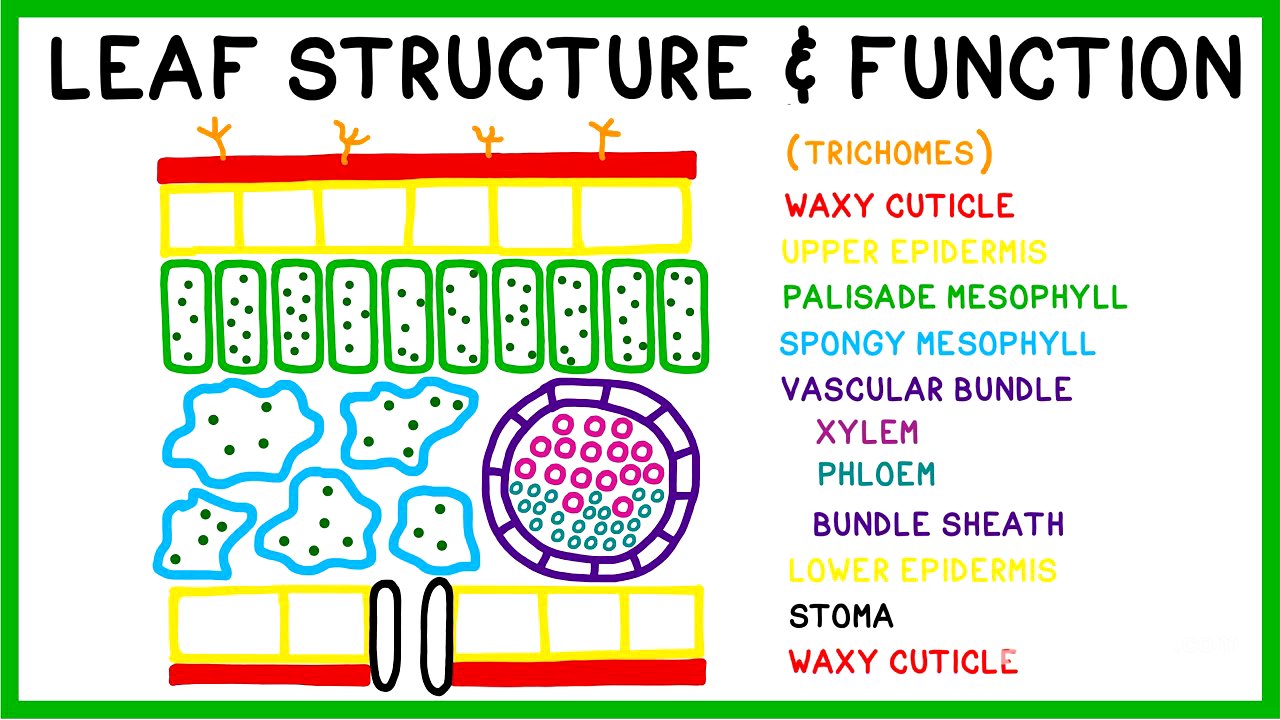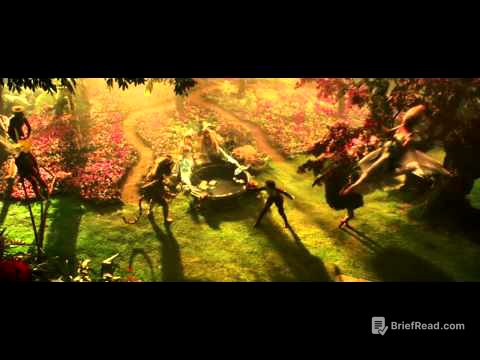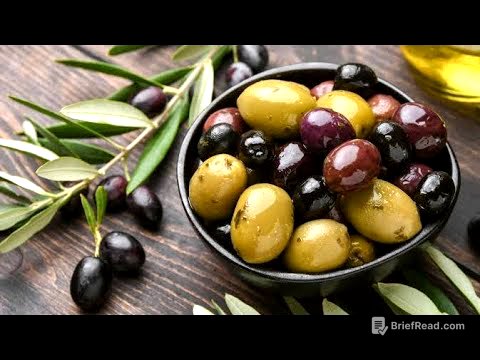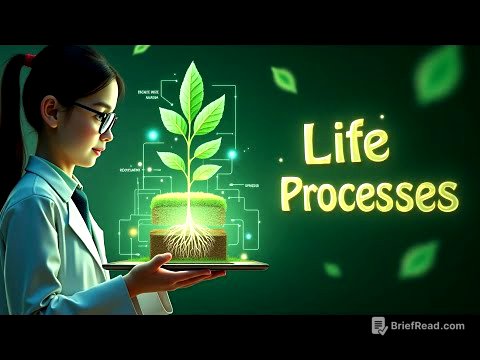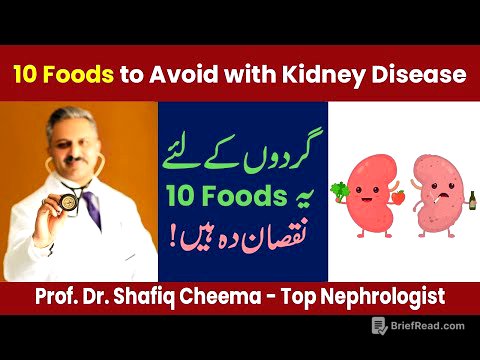TLDR;
This video provides an overview of the internal structure of a leaf and its relation to photosynthesis. It covers the different layers and tissues within a leaf, including the waxy cuticle, epidermis, mesophyll, and vascular bundles, explaining their specific functions in the processes of photosynthesis, gas exchange, and water transport. The video also touches on adaptations like C4 photosynthesis and protective structures like trichomes and terpenes.
- Photosynthesis involves the conversion of carbon dioxide and water into glucose and oxygen using sunlight.
- Key leaf structures include the waxy cuticle, upper and lower epidermis, palisade and spongy mesophyll, xylem, phloem, stomata, and guard cells.
- Adaptations like C4 photosynthesis and structures like trichomes and terpenes help plants survive in different environments.
Introduction [0:19]
The video introduces the topic of leaf structure and its connection to photosynthesis, highlighting that leaves have various internal structures each with specific functions. The video aims to explain these structures and their roles in photosynthesis.
Reagents and Products of Photosynthesis [0:32]
During photosynthesis, plants convert carbon dioxide and water into glucose and oxygen using sunlight. The video emphasizes observing which leaf structures handle these reagents and products throughout the explanation.
Types of Leaves [0:44]
There are two main types of leaves: simple and compound. Both types are responsible for gathering light from the sun, which plants use to create sugars and other carbon-rich compounds through the process of photosynthesis.
Waxy Cuticle [0:01]
The outermost layer of the leaf is the waxy cuticle, a thin, hydrophobic coating found on most leaves. This layer reduces water loss through transpiration, causing water to bead on the surface instead of being absorbed.
Upper Epidermis [0:01]
The upper epidermis is the first true layer of cells beneath the waxy cuticle. Its tightly packed cells help prevent water loss. In very hot or cold climates, this layer can be several cells thick. The upper epidermis is translucent, allowing light to pass through for photosynthesis.
Palisade Mesophyll/Palisade Parenchyma [0:01]
Beneath the upper epidermis is the palisade mesophyll, also known as palisade parenchyma. These cells are tightly packed, column-shaped, and filled with chloroplasts, making them the primary site of photosynthesis. Light passes through the waxy cuticle and upper epidermis to reach the chloroplasts within this layer.
Spongy Mesophyll/Spongy Parenchyma [0:02]
Below the palisade mesophyll is the spongy mesophyll, or spongy parenchyma. These cells are irregularly shaped compared to the palisade mesophyll but still contain some chloroplasts, allowing for some photosynthesis. The intercellular space between these cells facilitates gas exchange in and out of the leaf.
Vascular Bundle: Xylem [0:02]
The vascular bundle contains different tissues, including xylem. Xylem is a vascular tubule that transports water from the roots to the rest of the plant, flowing upwards. Water is a necessary reagent for photosynthesis.
Vascular Bundle: Phloem [0:02]
Phloem is the counterpart to xylem, also a vascular tubule, but its flow runs both up and down. It transports the products of photosynthesis from the leaves to the rest of the plant.
Vascular Bundle: Bundle Sheath Cells [0:03]
Surrounding the xylem and phloem is a network of tightly packed bundle sheath cells. In some plants, these cells enable a specialized form of photosynthesis, like the C4 pathway, that allows survival in dry environments.
Lower Epidermis [0:03]
The lower epidermis is a layer of epidermal cells on the lower surface of the leaf, similar to the upper epidermis. Its primary function is to prevent water loss.
Stomata & Guard Cells [0:03]
Within the lower epidermis are stomata, small openings that allow for gas exchange in and out of the leaf. Ideally, carbon dioxide diffuses in, and oxygen diffuses out. Each stoma is flanked by two guard cells that open and close in response to environmental conditions. Plants in hot environments may close their stomata to minimize water loss. Most stomata are located on the lower surface of the leaf.
Carbon Fixation in the Calvin Cycle [0:04]
Plants require carbon to produce glucose and other compounds. They obtain carbon through carbon fixation, extracting it from the atmosphere. During photosynthesis, plants convert atmospheric carbon from carbon dioxide into organic carbon within molecules like glucose.
C4 Pathway: Dry Climate Adaptations [0:04]
Plants in hot environments must balance carbon dioxide intake with water loss. C4 and CAM plants, which live in dry environments, have developed modified forms of photosynthesis to address this challenge. The lower portion of the leaf also typically has a waxy cuticle, similar to the upper portion.
Trichomes & Terpenes [0:05]
Many leaves have trichomes, additional structures on their surface that often make the leaf appear fuzzy. These hair-like structures deter plant-eating organisms and restrict insects from crawling on the leaf surface. Some trichomes store oily compounds called terpenes, which have powerful chemical properties and give plants like lavender, pine, and citrus fruits their distinctive smells. Terpenes are non-polar and water-insoluble, making them an effective defense mechanism that won't wash off in the rain.
Review Questions [0:05]
The video concludes by prompting viewers to examine a microscopic cross-section of a dicot leaf and identify the structures discussed. It also encourages viewers to consider the reagents and products of photosynthesis and recall which structures are associated with each.
